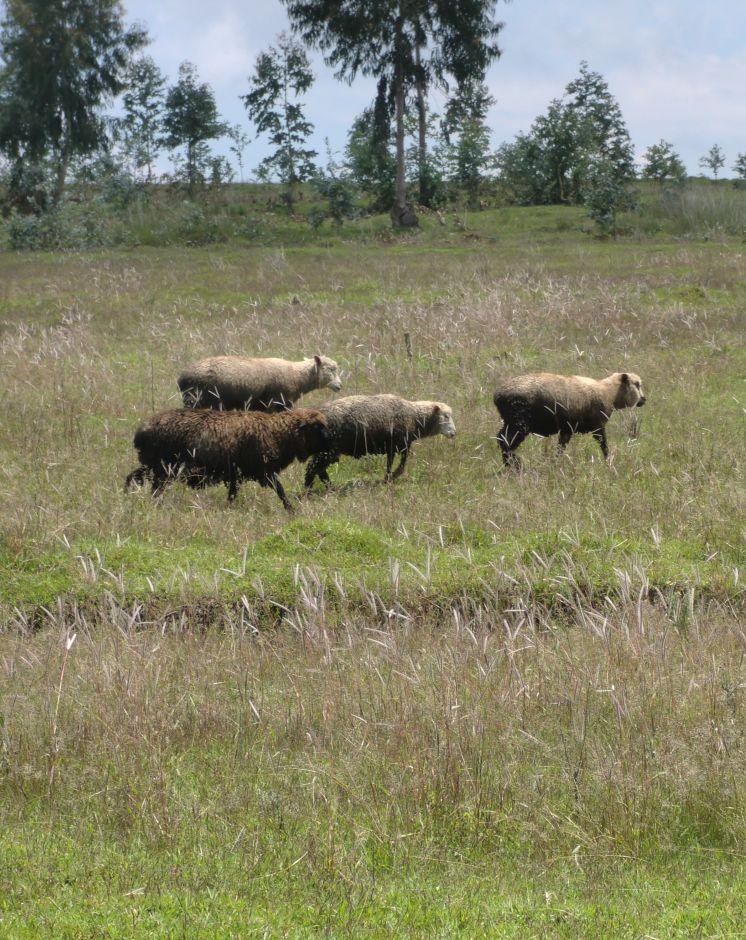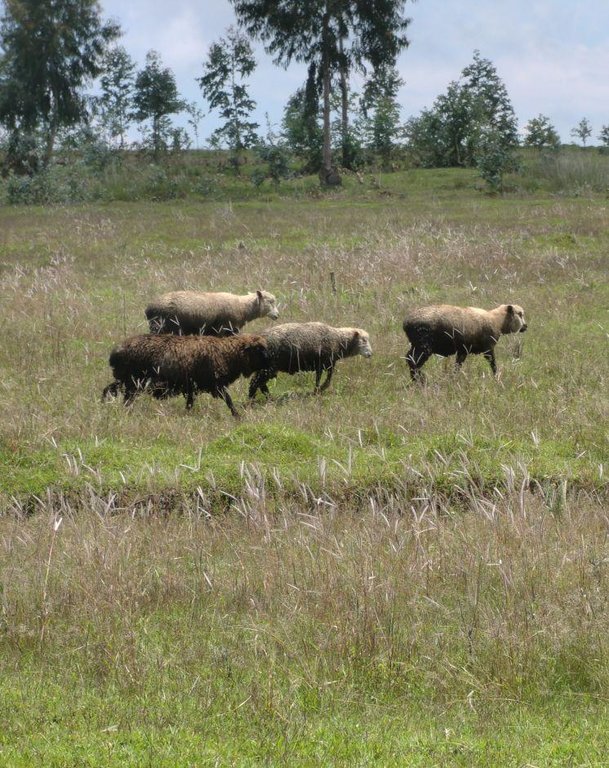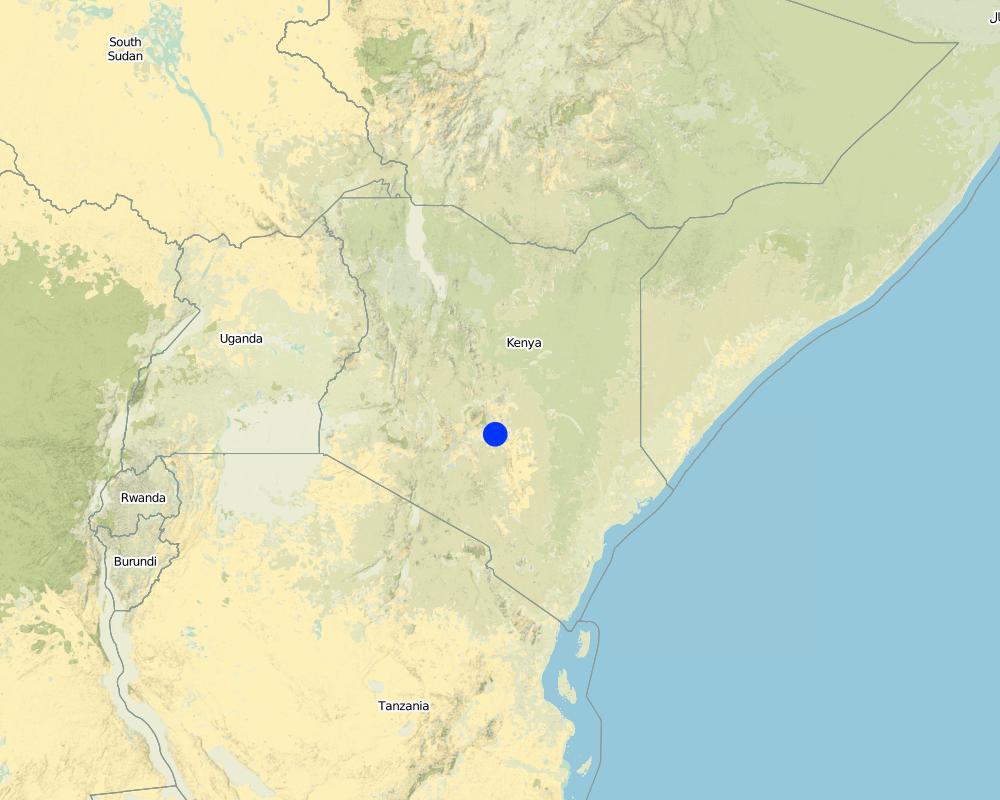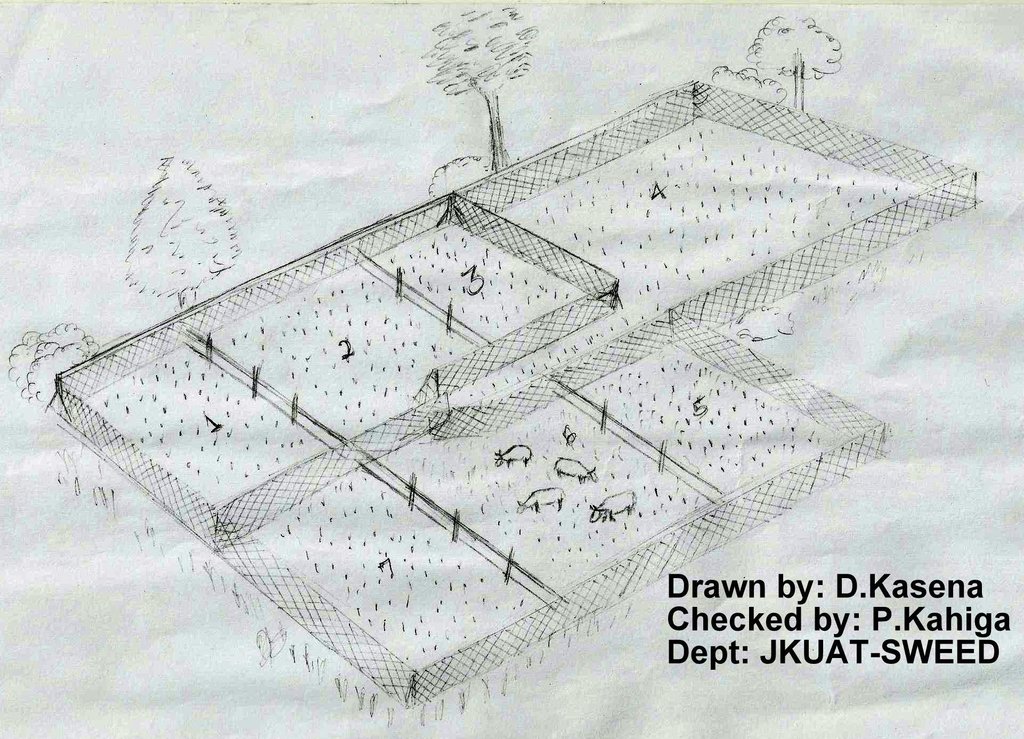Rotational grazing [肯尼亚]
- 创建:
- 更新:
- 编制者: Paul Kahiga
- 编辑者: –
- 审查者: Fabian Ottiger
Rotational grazing
technologies_1741 - 肯尼亚
查看章节
全部展开 全部收起1. 一般信息
1.2 参与该技术评估和文件编制的资源人员和机构的联系方式
SLM专业人员:
Gathenya Mwangi
Jomo Kenyatta University of Agriculture and Technology
P.O.Box, 62000-00200, Nairobi, Juja, Kenya
肯尼亚
SLM专业人员:
Home Patrick
Jomo Kenyatta University of Agriculture and Technology
P.O.Box, 62000-00200, Nairobi, Juja, Kenya
肯尼亚
SLM专业人员:
Chege Timothy
Jomo Kenyatta University of Agriculture and Technology
P.O.Box, 62000-00200, Nairobi, Juja, Kenya
肯尼亚
SLM专业人员:
Omwange Abamba
Jomo Kenyatta University of Agriculture and Technology
P.O.Box, 62000-00200, Nairobi, Juja, Kenya
肯尼亚
SLM专业人员:
Kimengich Baobab
Jomo Kenyatta University of Agriculture and Technology
P.O.Box, 62000-00200, Nairobi, Juja, Kenya
肯尼亚
SLM专业人员:
Wamuongo Jane
+254 729 054547
Kenya Agricultural Research Institute
Nairobi
肯尼亚
SLM专业人员:
Karanja Andrew
+254 729 054547
Kenya Agricultural Research Institute
Nairobi
肯尼亚
SLM专业人员:
Namirembe Sara
+254-20-722-4000
World Agroforestry Centre
United Nations Avenue, Gigiri PO Box 30677-00100 Nairobi
肯尼亚
有助于对技术进行记录/评估的机构名称(如相关)
Jomo Kenyatta University (Jomo Kenyatta University) - 肯尼亚有助于对技术进行记录/评估的机构名称(如相关)
KARI Headquarters (KARI Headquarters) - 肯尼亚有助于对技术进行记录/评估的机构名称(如相关)
International Centre for Research in Agroforestry (ICRAF) - 肯尼亚1.3 关于使用通过WOCAT记录的数据的条件
(现场)数据是什么时候汇编的?:
18/09/2012
编制者和关键资源人员接受有关使用通过WOCAT记录数据的条件。:
是
1.4 所述技术的可持续性声明
这里所描述的技术在土地退化方面是否存在问题,导致无法被认为是一种可持续的土地管理技术?:
否
2. SLM技术的说明
2.1 技术简介
技术定义:
Rotational grazing is a process whereby livestock are strategically moved to fresh paddocks, or partitioned pasture areas, to allow vegetation in previously grazed pastures to regenerate.
2.2 技术的详细说明
说明:
Mbeere South District is relatively dry and farmers have large chunks of land as compared to the Embu North District within the same county. Grazing is done on rotation from one piece of land to another depending on grass availability. Animals are either left to graze freely within the paddock or tethered depending on availability of laborer. In Mbeere South District, when the grass in paddocks gets exhausted, animals are fed on dry maize stalked harvested on the previous seasons. The dry maize stalks (fodder) is usually stored on a raised nest/perch where its covered from rain and sun.
Purpose of the Technology: Using this method cattle are concentrated on a smaller area of the pasture for a few days then moved to another section of pasture. This movement allows the grazed paddock a rest period that permits forages to initiate regrowth, renew carbohydrate stores, and improve yield and persistence.
Establishment / maintenance activities and inputs: When the animals have been shifted to the next paddock, this will allow grass and shrub to grow naturally and at the same time, the farmers are able to do repair of fence and hedge.
Natural / human environment: When utilized properly, rotational grazing can help farmers increase forage productivity. Rotational grazing can help improve productivity, weight gain or milk production per acre, and overall net return to the farm. Rotational grazing allows for better manure distribution that acts as a source of nutrients to the soil. Rotational grazing also has the potential to reduce machinery cost, fuel, supplemental feeding and the amount of forage wasted.
2.3 技术照片
2.5 已应用该技术的、本评估所涵盖的国家/地区/地点
国家:
肯尼亚
区域/州/省:
Eastern Province
有关地点的进一步说明:
Mbere South District
Map
×2.6 实施日期
如果不知道确切的年份,请说明大概的日期:
- 10-50年前
2.7 技术介绍
详细说明该技术是如何引入的:
- 通过土地使用者的创新
3. SLM技术的分类
3.1 该技术的主要目的
- 减少、预防、恢复土地退化
- 保护生态系统
3.2 应用该技术的当前土地利用类型

牧场
- Rotational grazing
注释:
Major land use problems (compiler’s opinion): The area was predominantly bushy and over grazed with remarkable soil erosion.
Future (final) land use (after implementation of SLM Technology): Grazing land: Gi: Intensive grazing/ fodder production
如果由于技术的实施而导致土地用途发生变化,则在技术实施前说明土地利的用途。:
Grazing land: Ge: Extensive grazing land
3.3 有关土地利用的更多信息
该技术所应用土地的供水:
- 混合雨水灌溉
每年的生长季节数:
- 1
具体说明:
Longest growing period in days: 90, Longest growing period from month to month: January to March
牲畜密度(如相关):
25-50 LU /km2
3.4 该技术所属的SLM组
- 轮作制度(轮作、休耕、轮垦)
3.5 技术传播
具体说明该技术的分布:
- 均匀地分布在一个区域
如果该技术均匀地分布在一个区域上,请注明覆盖的大致区域。:
- < 0.1 平方千米(10 公顷)
3.6 包含该技术的可持续土地管理措施

管理措施
- M2:改变管理/强度级别
3.7 该技术强调的主要土地退化类型

生物性退化
- Bc:植被覆盖的减少
注释:
Main causes of degradation: land tenure
Secondary causes of degradation: overgrazing
3.8 防止、减少或恢复土地退化
具体数量名该技术与土地退化有关的目标:
- 防止土地退化
- 减少土地退化
4. 技术规范、实施活动、投入和成本
4.1 该技术的技术图纸
4.2 技术规范/技术图纸说明
The technical drawing on the left shows a typical rotational grazing system. The animals are moved from one paddocks to the next on rotational basis.
Location: Mbeere South District. Eastern Province
Date: 30.11.2016
Technical knowledge required for field staff / advisors: low
Technical knowledge required for land users: moderate
Main technical functions: Allows for regeneration of pasture
Secondary technical functions: increase in nutrient availability (supply, recycling,…)
Change of land use practices / intensity level: Grazing in a particular paddock for sometime before moving the livestock in another paddock.
Major change in timing of activities: Rotational grazing
4.3 有关投入和成本计算的一般信息
其它/国家货币(具体说明):
Kshs
注明美元与当地货币的汇率(如相关):1美元=:
100.0
注明雇用劳工的每日平均工资成本:
500.00
4.4 技术建立活动
| 活动 | 措施类型 | 时间 | |
|---|---|---|---|
| 1. | Fencing | 管理 | Initial stage |
| 2. | Clearing the bushes | 管理 | Initial stage |
| 3. | Building the watering troughs and feeding points | 管理 | initial stages |
4.5 技术建立所需要的费用和投入
| 对投入进行具体说明 | 单位 | 数量 | 单位成本 | 每项投入的总成本 | 土地使用者承担的成本% | |
|---|---|---|---|---|---|---|
| 劳动力 | Labour | ha | 1.0 | 250.0 | 250.0 | 100.0 |
| 设备 | Tools | ha | 1.0 | 200.0 | 200.0 | 100.0 |
| 施工材料 | Nails and barbes wire | ha | 1.0 | 100.0 | 100.0 | 100.0 |
| 施工材料 | Wooden post | ha | 1.0 | 50.0 | 50.0 | 100.0 |
| 技术建立所需总成本 | 600.0 | |||||
4.6 维护/经常性活动
| 活动 | 措施类型 | 时间/频率 | |
|---|---|---|---|
| 1. | Repairing of the fence | 管理 | when the livestock have moved to other paddocks |
| 2. | Repairing the watering points and feeding troughs | 管理 | when the livestock have moved to other paddocks |
| 3. | Moving the livestock to the subsequent paddocks | 管理 | any time of shift |
4.7 维护/经常性活动所需要的费用和投入(每年)
| 对投入进行具体说明 | 单位 | 数量 | 单位成本 | 每项投入的总成本 | 土地使用者承担的成本% | |
|---|---|---|---|---|---|---|
| 劳动力 | Labour | ha | 1.0 | 200.0 | 200.0 | 100.0 |
| 设备 | Tools | ha | 1.0 | 150.0 | 150.0 | 100.0 |
| 施工材料 | Nails and barbes wire | ha | 1.0 | 50.0 | 50.0 | 100.0 |
| 施工材料 | Wooden post | ha | 1.0 | 30.0 | 30.0 | 100.0 |
| 技术维护所需总成本 | 430.0 | |||||
4.8 影响成本的最重要因素
描述影响成本的最决定性因素:
The most determining factors of this technology is labour and initial cost of constructing the paddocks and the overall maintenance.
5. 自然和人文环境
5.1 气候
年降雨量
- < 250毫米
- 251-500毫米
- 501-750毫米
- 751-1,000毫米
- 1,001-1,500毫米
- 1,501-2,000毫米
- 2,001-3,000毫米
- 3,001-4,000毫米
- > 4,000毫米
农业气候带
- 半干旱
Thermal climate class: subtropics
5.2 地形
平均坡度:
- 水平(0-2%)
- 缓降(3-5%)
- 平缓(6-10%)
- 滚坡(11-15%)
- 崎岖(16-30%)
- 陡峭(31-60%)
- 非常陡峭(>60%)
地形:
- 高原/平原
- 山脊
- 山坡
- 山地斜坡
- 麓坡
- 谷底
垂直分布带:
- 0-100 m a.s.l.
- 101-500 m a.s.l.
- 501-1,000 m a.s.l.
- 1,001-1,500 m a.s.l.
- 1,501-2,000 m a.s.l.
- 2,001-2,500 m a.s.l.
- 2,501-3,000 m a.s.l.
- 3,001-4,000 m a.s.l.
- > 4,000 m a.s.l.
5.3 土壤
平均土层深度:
- 非常浅(0-20厘米)
- 浅(21-50厘米)
- 中等深度(51-80厘米)
- 深(81-120厘米)
- 非常深(> 120厘米)
土壤质地(表土):
- 中粒(壤土、粉土)
表土有机质:
- 中(1-3%)
如有可能,附上完整的土壤描述或具体说明可用的信息,例如土壤类型、土壤酸碱度、阳离子交换能力、氮、盐度等。:
Soil fertility: Medium
Soil drainage/infiltration: Medium
Soil water storage capacity: Medium
5.4 水资源可用性和质量
地下水位表:
5-50米
地表水的可用性:
中等
水质(未处理):
不良饮用水(需要处理)
5.5 生物多样性
物种多样性:
- 中等
5.6 应用该技术的土地使用者的特征
非农收入:
- 收入的10-50%
相对财富水平:
- 平均水平
个人或集体:
- 个人/家庭
性别:
- 女人
- 男人
说明土地使用者的其他有关特征:
Land users applying the Technology are mainly common / average land users
Difference in the involvement of women and men: Men build the paddocks while women move the livestocks
5.7 应用该技术的土地使用者拥有或租用的平均土地面积
- < 0.5 公顷
- 0.5-1 公顷
- 1-2 公顷
- 2-5公顷
- 5-15公顷
- 15-50公顷
- 50-100公顷
- 100-500公顷
- 500-1,000公顷
- 1,000-10,000公顷
- > 10,000公顷
这被认为是小规模、中规模还是大规模的(参照当地实际情况)?:
- 小规模的
5.9 进入服务和基础设施的通道
健康:
- 贫瘠
- 适度的
- 好
教育:
- 贫瘠
- 适度的
- 好
道路和交通:
- 贫瘠
- 适度的
- 好
金融服务:
- 贫瘠
- 适度的
- 好
6. 影响和结论性说明
6.1 该技术的现场影响
社会经济效应
生产
饲料生产
饲料质量
畜牧生产
生产故障风险
社会文化影响
食品安全/自给自足
注释/具体说明:
Agricultural land used for grazing
SLM/土地退化知识
冲突缓解
注释/具体说明:
Animals are restricted and don't go to neighbours land
Improved livelihoods and human well-being
注释/具体说明:
Farmers have benefited from enhanced animal production
生态影响
土壤
土壤覆盖层
养分循环/补给
生物多样性:植被、动物
动物多样性
6.2 该技术的场外影响已经显现
对邻近农田的破坏
注释/具体说明:
Animals don't stray
对公共/私人基础设施的破坏
注释/具体说明:
Animals don't stray
6.4 成本效益分析
技术收益与技术建立成本相比如何(从土地使用者的角度看)?
短期回报:
积极
长期回报:
积极
技术收益与技术维护成本/经常性成本相比如何(从土地使用者的角度看)?
短期回报:
稍微积极
长期回报:
积极
6.5 技术采用
注释:
There is a moderate trend towards spontaneous adoption of the Technology
Comments on adoption trend: The rotational grazing technology requires big grazing land unit
6.7 该技术的优点/长处/机会
| 编制者或其他关键资源人员认为的长处/优势/机会 |
|---|
| In rotational grazing, there is increase in forage production. |
| A well-managed rotational grazing system has low pasture weed establishment, majority of niches are already filled with established forage species. |
| Spreading of manure around the whole pasture land |
6.8 技术的弱点/缺点/风险及其克服方法
| 编制者或其他关键资源人员认为的弱点/缺点/风险 | 如何克服它们? |
|---|---|
| In rotational grazing, there is need for more fence to be constructed | Construction of temporary fences that can be moved when need arises |
| More time is required to move the livestock from one paddock to the next one. | Adherence to the time schedules |
| In rotational grazing, there is a need to have water and access to shade from each smaller paddock. | The watering points can be automated |
7. 参考和链接
7.1 信息的方法/来源
- 实地考察、实地调查
- 与土地使用者的访谈
链接和模块
全部展开 全部收起链接
无链接
模块
无模块





